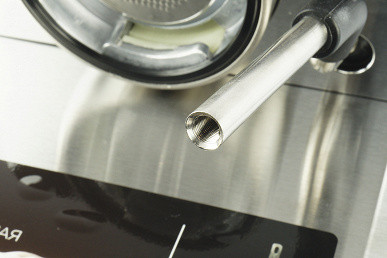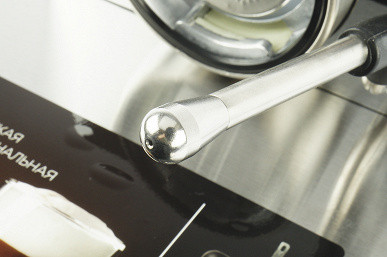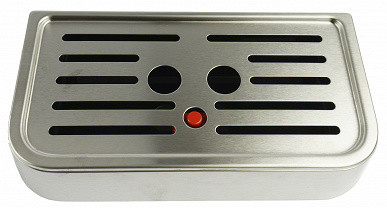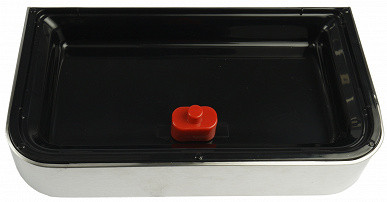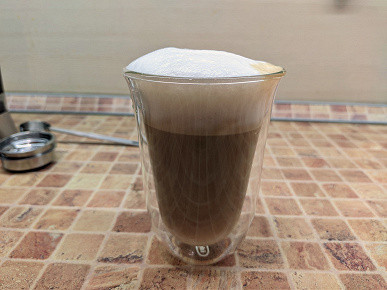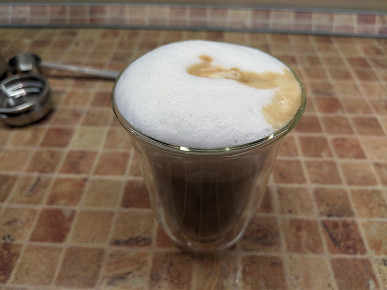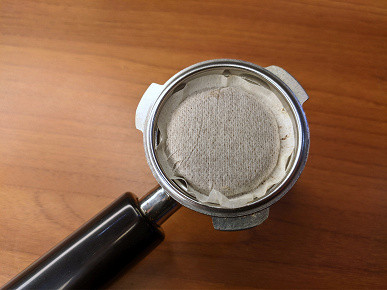Today we will look at the Redmond CM711 carob coffee maker. This device belongs to the category of budget coffee makers, but at the same time offers functionality typical of more expensive models.

Despite the standard filling, this coffee maker model has several attractive features. Its body is almost entirely metal, and there is a pressure gauge on the front panel. Included with the device we found a filter for pods, a metal tamper, a measuring spoon and a compact pitcher. This means you have everything you need to make coffee without the hassle of shopping for accessories. The main thing is that the built-in modes and programs live up to expectations. We will find out this during our testing.
Characteristics
| Manufacturer | Redmond |
|---|---|
| Model | CM711 |
| Type | carob coffee maker |
| Country of Origin | China |
| Guarantee | 1 year |
| Life time * | 3 years |
| Declared power | 1100 W |
| Housing material | plastic, metal |
| Tank capacity | 1.5 l |
| Pressure | 20 bar |
| Control | electromechanical |
| Weight | 5.1 kg |
| Dimensions (W×H×D) | 204×251×302 mm |
| Network cable length | 0.75 m |
* Contrary to popular belief, this is not the time limit after which the device will necessarily break down. However, after this period, the manufacturer ceases to bear any responsibility for its performance and has the right to refuse to repair it, even for a fee.
Equipment
The coffee maker comes in a simple and elegant box from Redmond. Its design is more reminiscent of boxes for semi-professional coffee makers than for ordinary home appliances. On the packaging you can see a photo of the coffee maker and get acquainted with its main technical characteristics.

Upon opening the box we found the following items inside:
- The coffee maker itself
- Horn
- Two filters for ground coffee and one for pods
- Metal measuring spoon
- Metal tempera
- Compact pitcher
- Instructions
- Booklet with recipes
- Warranty card and promotional materials
The equipment turned out to be expanded, which will certainly please the future owner. We always prefer metal accessories over plastic, and in this case we received them right along with the coffee maker. Great, isn't it?
At first sight
Our device, despite belonging to the upper segment of budget carob coffee makers, is generally a standard model. The core specs aren't all that different from other similar models in this price range (though there are, of course, some differences).
At first glance, the coffee maker makes an impression. All details of the case look strict and stylish. The developers claim an “all-metal body,” but in fact, all surfaces are covered with metal sheets except the top, which for some reason is made of plastic painted to look like metal. This fact is a little disappointing. Was it possible to do without plastic?

The coffee maker is assembled with high quality: there is no play, creaking or unpleasant noise. It's hard not to notice that the device looks more expensive than it actually costs. Dimensions correspond to the standard for home models.
Despite the fact that plastic is used inside the device, the metal exterior gives the coffee maker a stylish look. The metal panels look very neat; they fit snugly together without visible gaps, even in difficult areas of the body.

The control panel cover is made of plastic, which is a bit disappointing. After all, it is this that most often has to be cleaned, which means microscopic scratches are inevitable. In addition, plastic easily collects fingerprints.
However, the stand for storing and warming cups is made of metal, which seems more suitable for such an element.
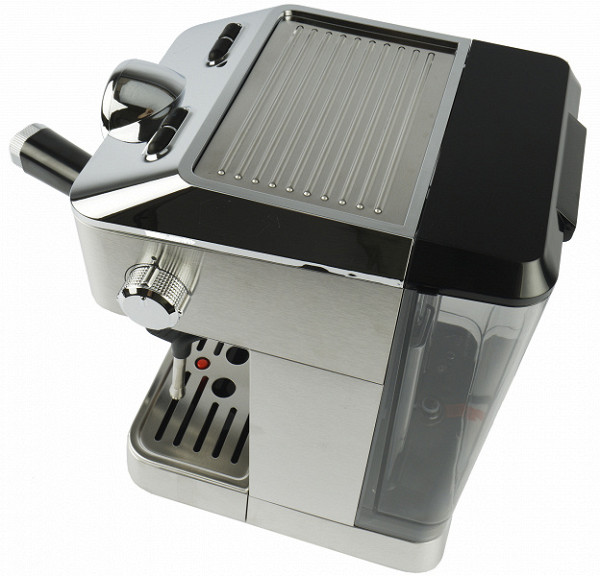
The weight of the coffee maker is 5.1 kg.
On the bottom of the coffee maker there are rubber feet and a sticker with the model number and technical information. There are also ventilation holes here. However, there is no cord storage compartment: a short cord is simply removed from the back of the device.

The removable water container is located at the back of the coffee maker, which does not impose potential restrictions on the placement of the device in the kitchen.
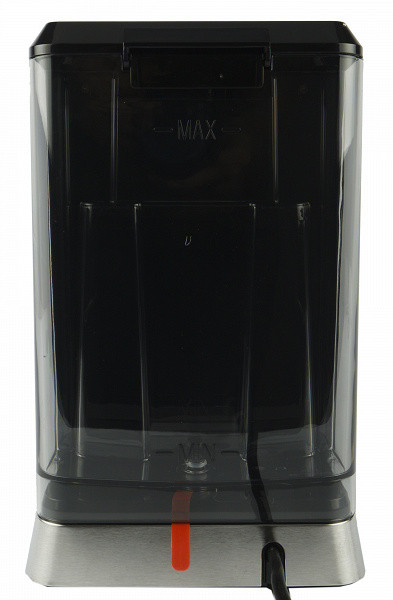
The cappuccino maker on our coffee maker is directed to the right, so you will need some free space on this side of the device.
The water container is made of transparent darkened plastic and has a capacity of 1.5 liters, which assumes the active use of both a coffee maker and a cappuccino maker. The Min and Max marks indicating the minimum and maximum water levels are located on the rear, so you must remove the tank completely to view them. We prefer to add water from above; for this purpose, the coffee maker is equipped with a hinged plastic lid. The container is fixed in the device body with a slight click, but there is no special handle or other mechanism for this.
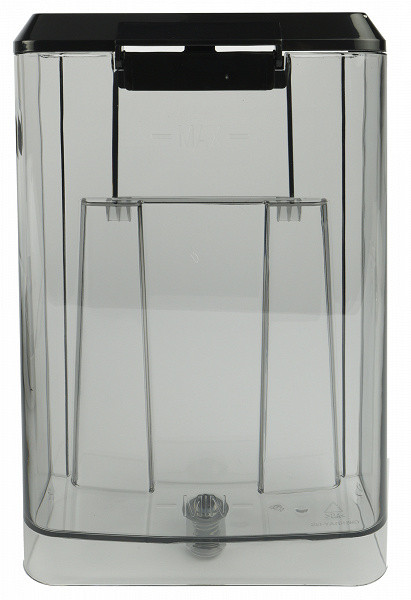
Water is supplied to the coffee maker through a valve located at the bottom and equipped with a simple mesh filter.
To the right of the coffee maker there is a cappuccino maker tube, equipped with a rubber grip to prevent burns, as well as a removable metal pannarello nozzle. This element looks like those found in higher-end coffee makers. When removing the nozzle, direct steam access opens through the metal tube, without the use of additional plastic elements.
...and here we have a pleasant discovery: the cappuccino maker tube not only rotates to the right/left, but also has the ability to adjust the tilt up/down. This allows you to set the optimal angle for working with the pitcher. We can't think of another budget coffee maker with similar functionality. Typically, this feature is present only in professional or semi-professional models. The distance from the working surface to the cappuccino maker tube is no more than 9 centimeters, which imposes some restrictions on the size of the pitcher (milk foam jug).
Above the cappuccino maker's horn there is a plastic steam supply handle, which has two operating positions (on and off). There are clear pictogram icons next to the handle on the body of the coffee maker.
We also pay attention to the brewing group. It is almost entirely metal (except for a small amount of plastic inside). Water enters through a steel strainer with a large number of holes. Open and closed lock icons help you position the horn correctly and secure it.

The horn of our coffee maker is installed with the handle to the left and tightened by moving it towards you. You can install a cup up to 8.5 cm high under the horn.
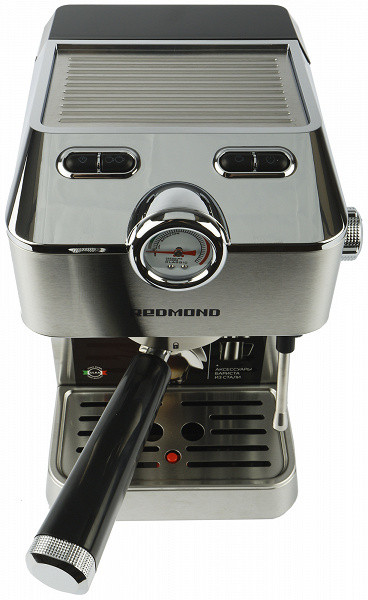
Under the cup there is a metal stand and a removable plastic drip tray. Thanks to its thoughtful design, the plastic part remains invisible in everyday use. The pan also has a full indicator — a red plastic float.
On top of the coffee maker there is a metal stand for cups. Although there is no actual heating of the cups (this feature is missing on budget models), the cups still warm up a little thanks to the heat transfer from the coffee maker.
The horn has a diameter of 51-52 mm and is equipped with a plastic handle. The main material of the horn is light white metal, and the handle and its attachment are also made of plastic, painted to resemble metal. Externally, the horn looks quite simple, which is typical for budget models of coffee makers.
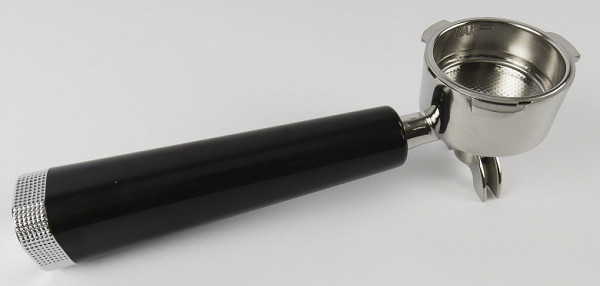
Note that the handle of the horn is quite long — as much as 14.5 cm.
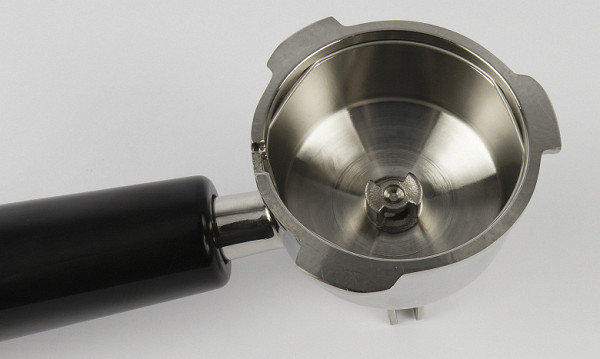
The cone comes complete with two filters for 1 or 2 cups respectively. Both filters have a double bottom, which is typical for home filters. This compensates for potential user errors and ensures a consistent coffee taste even if the grind or dosage is incorrect. In the inner part of the filter, under the main perforated mesh, there is a second bottom with a small hole in the center.
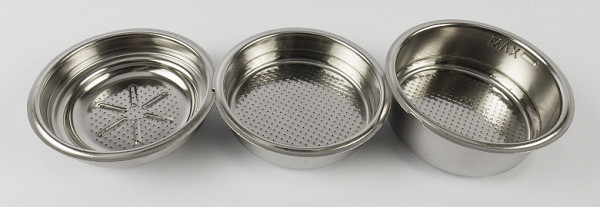
The additional filter that we found in the box with the coffee maker is designed for making coffee in pods. This accessory is extremely rare in budget models, so its presence is a pleasant surprise.
The filters are attached inside the horn using a special spring, similar to “adult” models. They are held in place quite firmly, requiring some effort to remove.
Coffee is dispensed through two spouts, allowing you to brew two cups at the same time. Along the coffee route, we did not find any plastic, and the spouts look exactly the same as those of semi-pro or professional models.

In the kit we found a metal measuring spoon, the volume of which is 15 ml, according to the inscription on the handle.

The set also includes a metal tamper with a removable plastic handle. This is especially valuable since there is no need to order it separately and spend additional money and time on trips to the store. This eliminates the possibility of an error in choosing the wrong tamper by diameter.
The third accessory is a 330 ml metal pitcher. It looks standard, but its inclusion in the kit makes the process of making coffee easier and saves additional costs. On the inside of the pitcher there are graduations from 120 to 330 ml in 60 ml increments and from 4 to 11 oz in 2 oz increments.

In general, the coffee maker leaves a very positive impression, with the exception of the plastic top panel. The accessories are also pleasantly surprising — not only for their quality, but also because they allow you to start preparing espresso and cappuccino right away, without the need for additional trips to the store. I'm very pleased with this approach!
Instructions
The user manual is presented in the form of a compact black and white brochure printed on high-quality paper. The instructions are written in simple and understandable language, making it easy and enjoyable to read. The authors avoid unnecessary information by highlighting it in a separate font, which allows the reader to focus on the main material.

Basic operations when using the device are clearly explained with simple and clear illustrations. To get acquainted with the main functions, it is enough to study just six compact pages.
In addition to this, the box also contains a full-color brochure with recipes for coffee drinks. This brochure is presented in a colorful design and contains useful and interesting information.
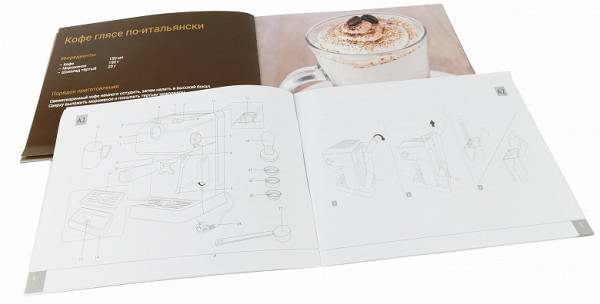
Control
The control panel of the coffee maker is equipped with four electromechanical buttons with white LED backlight and a rotating cappuccino maker handle. Let's look at each element and understand their functions.
The buttons on the panel have a rubber coating, pleasant to the touch, and are pressed with a soft click. The backlighting of the buttons is bright and looks nice. When you press the buttons, a short sound signal (squeak) is emitted.
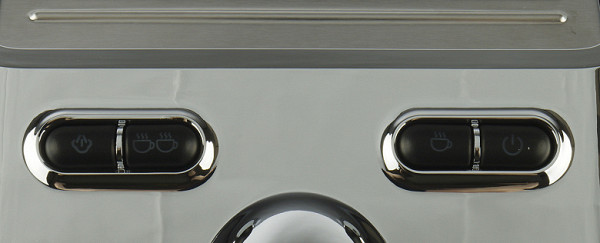
The handle of the cappuccino maker is made of plastic, painted to look like metal. This is a typical solution for home coffee makers, although it looks somewhat budget-friendly.
The icons on the buttons are clear and intuitive:
- The rightmost button is to turn the coffee maker on and off.
- Next to it is a button for preparing a single espresso.
- The one on the far left is the steam button.
- Next to it is a button for preparing double espresso.
After turning on, the coffee maker warms up for a while, during which time the backlight flickers. When the light turns on continuously, the coffee maker is ready for use.
The cappuccino maker handle allows you to turn on the hot water to quickly prepare an Americano. If you first press the “steam” button and let the coffee maker warm up, steam will be released.
Although the knob rotates, there are actually only two positions: on and off.
The user can also change the default settings for single and double espresso. To do this, you need to hold down the corresponding button, and then start and stop preparing the drink manually.
Drink volumes can be adjusted from approximately 40 ml to 200 ml. It is worth noting that a volume of 40 ml is already considered lungo, not espresso, so many users prefer to prepare double portions.
The pressure gauge next to the buttons helps control the pressure when brewing coffee. Although it does not have a number scale, there is a «green zone» that indicates the correct pressure while brewing the drink.
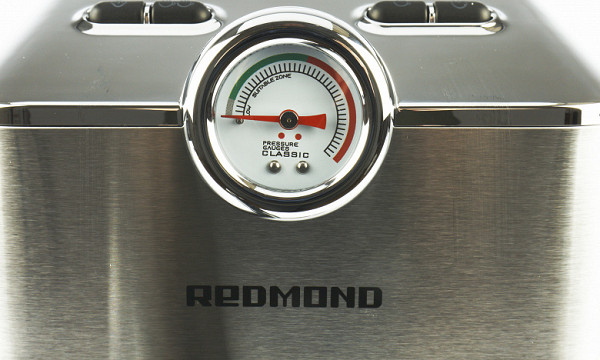
Exploitation
Before use, you should wash the water tank, horn, filter and tray, wipe the body of the coffee maker with a damp cloth and rinse the device by starting the coffee preparation mode (without coffee), and also release some steam and hot water to get rid of any remaining air in the system. After completing these steps, the coffee maker is ready to use.
During testing, the coffee maker proved to be convenient and easy to use. The water container fits easily into the housing and can be refilled without having to be removed. The filters are installed in the horn using a special wire and are held securely. The drip tray can be easily removed and replaced, and a red float indicates when it is empty.
The maximum cup height suitable for use with the coffee maker is 8.5 cm. If necessary, you can remove the drip tray if the cup is too high. To work with the cappuccino maker, a pitcher with a height of up to 9.5 cm is required, which corresponds to the supplied pitcher.
An important advantage is that the top metal panel warms up a little due to the internal heater, making the cups warm.
The user can adjust the volume of the drink at his discretion. Steam and hot water are supplied from the cappuccino maker quite intensively, so it is recommended to get used to the process to avoid splashes.
No deficiencies were found during operation. The quality of the drinks will be discussed in the “testing” section.
Care
Caring for your coffee maker includes the following:
- Rinse the horn after each coffee preparation. It is recommended to store the horn separately for faster drying.
- Periodic washing and cleaning of the filter and the space under it.
- Clean the steamer after each preparation of frothed milk to avoid milk stagnation, which can harden and become more difficult to remove.
- Timely cleaning and emptying of the drip tray.
- Wipe the coffee maker body with a soft cloth.
- If scale forms in the coffee maker, it should be washed with a special product. A 3% solution of citric acid is suitable for this, which needs to be poured instead of water and run the coffee maker in self-cleaning mode.
Our measurements
Before testing, we measured the energy consumption and time required to prepare the coffee maker for use. The power of the coffee maker in heating mode was up to 1020 W, which corresponds to the declared characteristics.
However, the preparation time for operation may vary: in some cases (especially after a long period of inactivity) the device took up to 2 minutes and 40 seconds to warm up. This may seem strange, given the use of a flow-through thermoblock, which usually provides rapid warm-up.
It takes up to 25 seconds for the coffee maker to warm up until it is ready to dispense steam or hot water.
In hot water mode, the coffee maker dispenses approximately 170 ml of water in 45 seconds with a temperature in the mug of about 79°C.
The noise level when operating the coffee maker is assessed as low, not exceeding 63 dBA.
Practice tests
While testing the coffee maker, we successively prepared single and double espresso, as well as cappuccino, to test the operation of the cappuccino maker. We also tested the ability to brew coffee in pods.
For our tests, we used a standard grind, similar to what we use to make espresso on semi-professional carob coffee makers. It should be noted that our coffee maker prepares coffee with pre-wetting. She starts by running hot water for about 4 seconds before the main brewing process.
We started with a single espresso. The filter holds about 9 grams of coffee per serving.

Our single espresso at standard settings weighed 43 grams (using 8.4 grams of coffee). The temperature of the first espresso after turning on the coffee maker in an unheated cup was 63°C — not too high. Cooking time was 15 seconds (plus 4 seconds for pre-wetting).
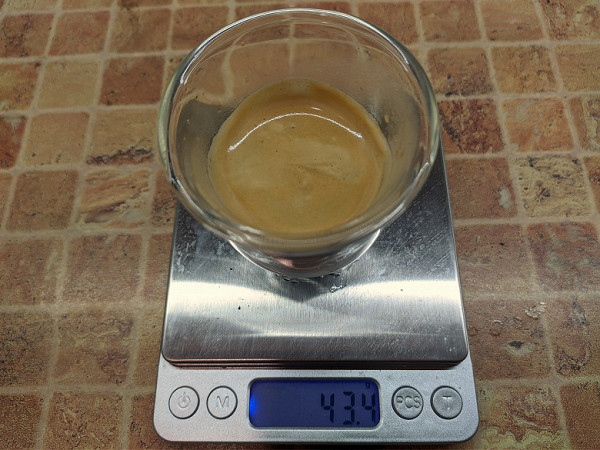
As we can see, single espresso looks good. There is even a small foam of cream, although not in large volume. We rate it as average in taste.
Previously, we sought to evaluate drinks formally, taking into account pouring time, temperature and other standards. However, we recently decided to focus on subjective feelings. Although the volume of coffee beans, pouring time and temperature play an important role, for budget coffee makers with an “improver” filter there are no strict standards like professional machines. Therefore, we will not strictly adhere to these parameters.
The double serve filter holds approximately 15 grams of coffee.
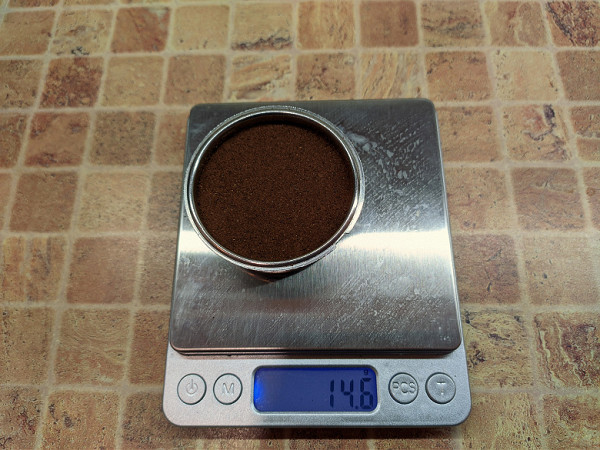
Double espresso is ready in 25 seconds (plus pre-wetting). The result is a drink weighing about 53 grams, with a temperature of about 74 °C. This is much better than when preparing a single portion.
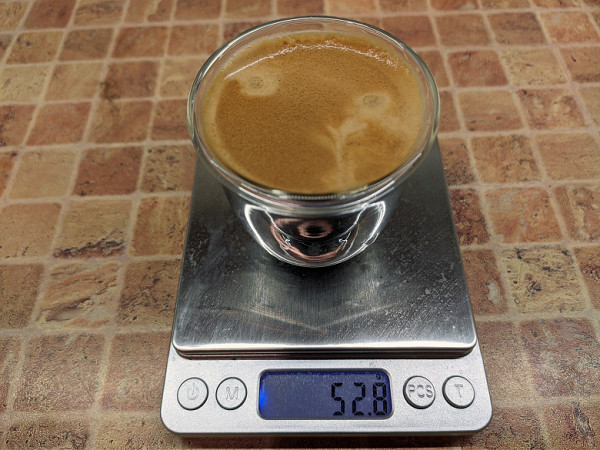
Even without additional measurements, it is clear that the result has improved significantly. The taste is rated as good, and so is the appearance. Although the filter with the “improver” frothed the coffee a little, so the foam of the cream does not look entirely fair. The temperature of the finished drink is also pleasant. If you warm the cup slightly (or rinse it with hot water), everything will be fine.
The spent coffee tablet remains moist in the coffee maker. Shaking it out of the filter will not be very convenient. So, if the filter does not need to be changed, it is easier to rinse the horn along with the filter under running water.

Okay, let's move on to frothing the milk. To do this, we took 200 ml of milk from the refrigerator, poured it into the pitcher and turned on the steam supply, after releasing a small amount of water from the cappuccino maker and lowering the cappuccino nozzle into the milk to avoid splashing. The coffee maker took 25 seconds to prepare to produce steam.
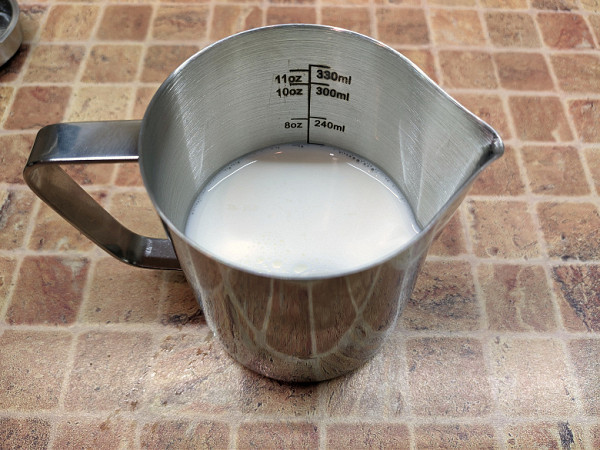
In less than a minute we received a thick and stable milk foam...
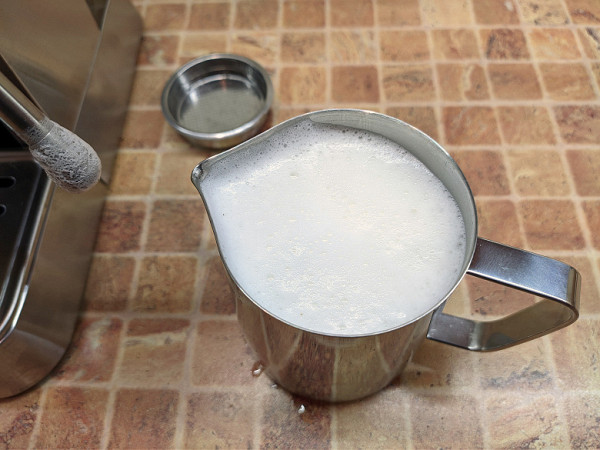
...which will allow you to quickly prepare coffee and milk drinks.
The steam is supplied evenly and quite intensely, so it is not recommended to pour more than 200 ml of milk into the pitcher.
When using hot water supply, the temperature in the cup will be 79 °C, which is suitable for making an Americano.
Finally, let's move on to making coffee in pods. Here we are faced with the fact that the filter for the pods is inserted into the horn with some effort. Therefore, removing it may not be very convenient. You may need to use an additional tool, such as a regular teaspoon.
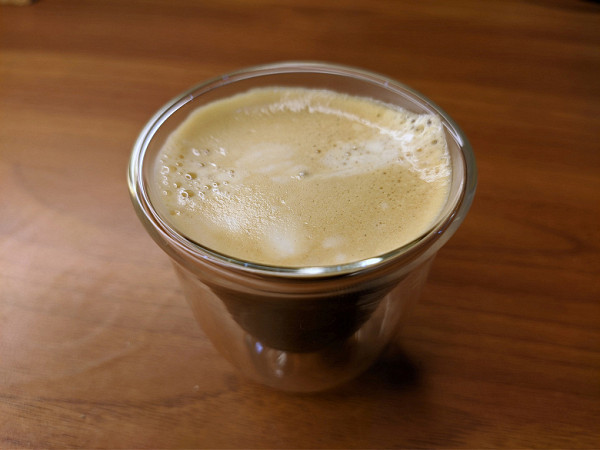
The finished drink had a pleasant appearance. Regarding taste, it largely depends on the pods themselves. Our coffee was a very pleasant combination, a bit reminiscent of capsule coffee due to the use of additional flavorings. Overall, the coffee maker coped with its task, although the speed of pouring water in this mode was a little higher than we expected.
So, if you don't want to bother with a coffee grinder or want a variety of flavors to choose from, using coffee pods may be a good idea.
conclusions
Overall, the Redmond CM711 coffee maker met our expectations. Despite its budget status, it is a quality device. The technical characteristics also did not disappoint: the temperature conditions and water pouring speed are suitable for making espresso.
It’s especially nice that the coffee maker comes with decent accessories: a measuring spoon, a pitcher and a tamper. This eliminates the need to purchase them separately, which will certainly please coffee lovers. It is also worth highlighting the presence of a special filter for pods.
The height adjustment of the cappuccino maker and the reliable fastening of the filters in the horn using a special spring are positive.
It should also be noted the possibility of pre-wetting, quick production of hot water (for Americano) and milk foam (for cappuccino and other milk drinks).

There is room for improvement in a number of areas. For example, some users may note the plastic top panel and the relatively long initial warm-up time of the coffee maker as disadvantages. To obtain the best quality drink, it is recommended to turn on the device a little earlier and prefer the use of a double filter, as this guarantees a higher quality espresso.
Despite some shortcomings, the Redmond CM711 coffee maker is a very worthy device in its price segment. We could confidently use it at home or in the office, which is a testament to its quality among budget coffee makers.
Pros:
- reasonable price
- stylish appearance
- two modes — single and double espresso
- filter for working with pods
- programmable portion volume
- pre-wetting mode
- hot water supply
- accessories included
Minuses:
- plastic part of the body
- relatively long warm-up time

